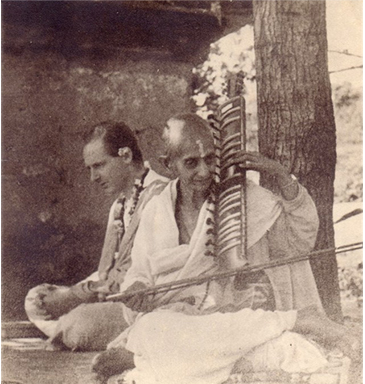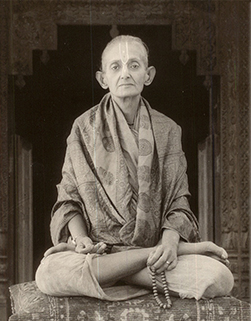Sri Yashoda Ma (1882-1944) – Ma to her pupils – was born to a Bengali family in Ghazipur, a town in northern India on the banks of the river Ganges. Her father, Rai Bahadur Gagan Chandra Roy, was a well-known figure in the town and their house regularly hosted visitors. Acquaintances of the family included Swami Vivekananda, Keshab Chandra Sen and many sadhus, and these meetings had a deep impact on Monica’s innate spiritual nature. The night Gagan Roy’s daughter was born, a Christian bishop was staying there; he suggested they name her Monica, as he had dreamt that night of St. Monica, mother of St. Augustine. And Monica it was, till she took the sannyas vows of renunciation.
Monica’s marriage was arranged to Dr Gyanendranath Chakravarti, who, being deeply spiritual himself, and a dedicated Theosophist, encouraged her on her path; and Banaras, where they lived, teemed with yogis and gurus whom she went to meet and question. The Chakravartis were a rather unique couple. They eventually had four children, of whom Arpita – better known as Moti Rani – was later to play a major role in the lives of Sri Krishna Prem and Sri Madhava Ashish; they also brought up and educated forty other children. When Dr Chakravarti became Vice-Chancellor of Lucknow University, Monica was called ‘the first lady of Lucknow society’.
Behind this persona, however, the wish to dedicate her life to the inner quest and renounce the world grew stronger; she asked her husband for initiation, and later took formal initiation at Brindaban.
As Vice-Chancellor, Dr Chakravarti had already invited Sri Krishna Prem – then still ‘Professor Ronald Nixon’ – to stay with them in their guest-house; as the months passed he became part of the family, and realized that it was Mrs Chakravarti who was his spiritual teacher. Around 1924 she was graced with an overwhelming vision of the ‘Unity of Being’, of which she wrote in a note to Professor Nixon: ‘What you are seeking, that I have found.’ She asked for her husband’s permission to live as a Vairagini and build a small temple to Sri Krishna in the Himalayan foothills near Almora, where they had acquaintances. Doctors had advised this location because of her lung trouble, while advising her husband that he needed to stay in the plains because of his chronic high blood pressure. Dr Chakravarti went to Almora and invested her with the ochre robe of the monk and the name ‘Sri Sri Krishna Sevika Sri Yashoda Mai Vairagini’, but his health forced him to return to Banaras.
The next two years passed in looking for a suitable plot of land that would be reasonably self-sufficient for a temple and ashram, and Professor Nixon was inducted into the order as Sri Krishna Prem. The temple was built – with all the attendant difficulties of construction in a remote rural area – and it was consecrated in 1931. The complex discipline of orthodox Hindu worship that Ma followed, if practised with inner understanding and not merely performed as outer ritual, is intended to produce the state of mindfulness or self-awareness that is the essential aim of all spiritual life. Her book Punaravartin was published in 1937 by Pandit Chandrashekhar Awasthi (Lucknow) and translated by Sri Krishna Prem into English as The Homeward Journey (unpublished).
Slowly, a few disciples came, a few cottages were built. These eventually included Ma’s daughter Moti Rani, Sri Krishna Prem's Cambridge friend Major Robert Alexander, and, later in 1946 Sri Madhava Ashish. Some of the land was used for growing wheat and potatoes and a few cows were kept. The condition of the forest land was so degraded that Ma ordered that green trees should not be cut, and even thorn bushes should be left because they protected any oak seedlings germinating under them from grazing cattle and goats – perhaps she was one of the first Indians to understand the environmental importance of forest cover! For a few years Ma ran a school for young boys to learn basic Hindi, English and arithmetic. The boys did so well in later life that, though the little school had to be closed owing to her ill-health, the local panchayat council decided to build a school in the nearest village, Panuanaula, which is now a thriving Inter-College.
Ma’s increasing frailty meant that Sri Krishna Prem had to perform all the temple rituals, including cooking and offering food, manage the estate, expound the teaching to visitors, guide disciples, and nurse his guru. When she died in 1944, he wrote to his friend in Pondicherry, the writer and singer Dilip Kumar Roy, ‘The end was utter peace… she was the pivot round which my whole universe revolved… That she still is, but still the loss of the physical support is hard to bear.’ At that period when he was so bereft (he later told Sri Madhava Ashish), he was woken for three nights in a row and heard Ma’s voice saying:
‘I am at one with the Lord.
I am at one with all beings.
I shall be with you always.’




